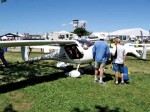by Ed Leineweber
It seems like the Sport Pilot/Light Sport Aircraft movement just can’t catch a break. The Federal Aviation Regulations, creating the new pilot certificate and new category of aircraft, finally went officially on the books in September, 2004, amid widespread anticipation that the cures for diminishing pilot numbers and increasing cost and complexity of new aircraft had been found. Now, a little more than seven years later, the optimistic anticipation has been replaced with widespread disappointment.
It’s been just one darn thing after another. First, dramatic deterioration in the euro/dollar exchange rate, which had favored the mostly-European early entrants into the Special Light Sport Aircraft (S-LSA) market, caused the price in U.S. dollars for these imports in increase substantially, often by 20 percent or more. Next, the global economy fell off a cliff, and the United States entered into what has been called the “Great Recession,” which in practical terms continues today for potential buyers and sellers of these aircraft. Then there was the run-up in commodities prices, which caused the cost of many aircraft materials to spike.

And now, the biggest potential whammy of all: the champion of the SP/LSA movement, the Experimental Aircraft Association (EAA), and the world’s largest pilot organization, the Aircraft Owners & Pilots Association (AOPA), have joined forces to petition the FAA for the acceptance of the “driver’s license medical,” which is one of the major drivers behind the Sport Pilot Certificate and S-LSA sales. It’s a wonder there is any steam left in this movement at all.
But before we pass out the crying towels, send out the condolences, and write the postmortems, let’s step back and take a look at the situation. It’s grim, for sure, but not without some still-smoldering embers that might yet erupt into joyful, bright flames.
Might As Well Start On The Downside
No matter how you try to spin the numbers to look good, it’s hard to conceal the facts that Sport Pilot Certificates issued, and S-LSA unit sales, over the first years of the new regulations, are a disappointment. According to the FAA, Sport Pilot Certificates issued through 2010, the last year for which official data is available, totaled 3,682. While this is certainly substantial growth from an initial issuance of 134 Sport Pilot Certificates in 2005, the first year that any such certificates were available, it is one-tenth of one percent of the total pilot population, and can hardly be said to even move the needle on the gauge measuring diminishing pilot numbers.
What is perhaps even more disappointing concerning Sport Pilot, the rate of growth year-over-year in the issuance of these entry level pilot certificates, is flattening out, perhaps portending even more disappointment to come. While the early years saw the Sport Pilot population multiplying at a skyrocketing rate, the 2009-over-2008 rate of growth was just 24 percent (625 new SP Certificates), and the 2010-over-2009 growth rate had slowed to 14 percent, with only 434 Sport Pilot Certificates having been issued in all of 2010.
Although this new pilot certificate has certainly fared better than the last attempt at easing access to piloting, the Recreational Pilot Certificate (for which only 212 remain active on the FAA airman records), these small numbers, and the diminishing rates of growth so early in the program, do not bode well. Can an additional 400 pilots a year, many of who might well have just pursued the Private Pilot Certificate if the SP alternative had not been available, really be the miracle cure that we would all like to see? I doubt it.

Nor can one take much solace in the hope that the creation of the Special Light Sport Aircraft Category, or the new ASTM industry consensus standards approach to designing, manufacturing and maintaining such aircraft, are going to draw substantial numbers of new pilots into the fold, or reverse the steadily increasing average age of the general aviation aircraft fleet, or the equally steady decline in serviceable GA aircraft. Once again, even a cursory look at the numbers tells the tale.
According to Dan Johnson, acknowledged S-LSA guru and cheerleader-in-chief (as head of the Light Aircraft Manufacturers Association (LAMA), the S-LSA industry trade association, through September, 2011, approximately 2,210 S-LSAs have been sold since the first ones hit the FAA registry after the 2004 creation of the new rules. Again, as with the growth pattern of the Sport Pilot Certificate, much of this activity occurred in the first years such aircraft were available on the market, with very little growth, and few individual sales, since 2008.
Although there are over 80 companies offering 120 models of S-LSAs, only the industry sales leader has more than 10 percent of the market, and the top 10 companies account for more than 70 percent of all sales. Indeed, the bottom 60-plus players (in terms of sales) have sold only 277 aircraft among them, and represent only about 13 percent of the market. It is doubtful whether some of these companies have sold more than one or two aircraft so far.
Clearly, this is not what the promoters of this new aircraft category, the entrepreneurs who invested heavily in these aircraft manufacturers, or the recreational aviation community generally, were hoping for back in 2004 when the champagne corks were popping. Nor are these sales levels going to do much to change the average age of the recreational aircraft fleet, or halt the gradual decrease in the fleet size.
Are We Now Facing The Abyss?
Okay, the results to date might not be what we would like, but progress has, after all, been made. We do have a new entry-level pilot certificate, and it has been much more successful than the last attempt. So too, the Special Light Sport Aircraft Category has done exponentially better than the Primary Aircraft Category offering of a couple of decades ago. Sometimes progress just takes longer than anyone could have anticipated, but the trend is still up. Right?
Maybe, or maybe not. Last September saw the announcement of the impending filing of the EAA/AOPA joint petition to create an exemption from the third class medical certificate regulations, allowing holders of all types of pilot certificates to fly recreationally with the same “driver’s license medical” permitted heretofore only to Sport Pilots. Wow! It also proposes to allow them to fly 56,000 aircraft of the existing GA fleet, subject to limitations similar to the Sport Pilot Certificate, but without the speed or weight restrictions of S-LSA. Ouch!
The details of the EAA/AOPA proposal, which has not yet as of this writing been officially filed as a rulemaking petition with the FAA, are still not fully determined. (Check out EAA’s and AOPA’s websites for the particulars.) But generally, the idea is to allow pilots to operate single-engine, fixed-gear aircraft with no more than four seats and 180 hp, so long as they carry no more than one passenger, and fly only in daytime VFR conditions. These operations could be conducted without a medical certificate as long as the pilot held a valid driver’s license and had attended within the previous 24 months an aeromedical course on self-certifying the pilot’s fitness to fly. These limits are pretty much what the Sport Pilot Certificate authorizes in a Sport Pilot-eligible aircraft.
Of course, no such petition has yet been filed, and once it has, it might be years before the FAA acts on it, and then it might just deny the petition, as it has many similar earlier attempts at removing or loosening the third class medical certificate requirements over the past 25 years. So let’s not overreact to what might never happen, you might be thinking.
Except that very measurable damage to the SP/LSA industry is already being reported. Dan Johnson has said that, as of last November, 12 sales contracts for new S-LSAs have been cancelled, with more expected to be axed in the coming months. For an industry that is only selling a couple hundred aircraft a year, that indeed is a significant hit.
Ancillary damage to other elements of the industry might be expected as well, including Sport Pilot training centers and S-LSA maintenance facilities. Beyond that, investors will be less likely to invest, and banks less likely to lend.
Let’s Be Positive
Don’t get me wrong. I am not opposed to the exemption petition, and don’t think that, all things considered, it is a bad idea. Even as a flight instructor who tends to focus on Sport Pilot training, a Light Sport Repairman-Maintenance Certificate holder, and a prospective dealer for a brand of S-LSA that is still working its way to the marketplace, I can see that this EAA/AOPA joint petition might, if successful, do more to revitalize recreational flying, and the industry that surrounds it, than the SP/LSA movement has been able to accomplish in its first seven years of existence. But it will be tough on those who placed their bets on the game figuring that the rules wouldn’t change, at least so soon.
And there is much that is positive, which the SP/LSA movement has already contributed to the recreational and general aviation scene. For instance, the proposed third class medical certificate exemption petition relies substantially on data that has accumulated under the Sport Pilot rule. Specifically, there has not been a single documented case of medical incapacity of a pilot operating with a “driver’s license medical” in the first seven years of its existence.
On the S-LSA side, the ASTM industry consensus standards method of developing new aircraft has proven so successful that it is likely to be the model for the upcoming revisions of FAR Part 23 aircraft certification regulations. Although there have been a few problem cases, this new system has produced a plethora of market entrants offering a breathtaking array of varied and innovative products, including engines, airframes, avionics and other aircraft components. A completely new approach to maintenance and continued airworthiness systems is being tested and proven in a real-world operating environment, and will likely affect how these tasks are managed in the traditional “certified aircraft” world in years to come.
And, while it might be bad news for SP/LSA industry participants, the proposed exemption petition is extremely good news for hundreds of thousands of pilots, as well as for the owners of tens of thousands of existing aircraft. (In my own case, for instance, I will be much less likely to want to sell my beautifully restored 1956 Champion 7EC two-place taildragger, even with its non-Sport Pilot eligible 1,450 lbs. gross weight.) Legions of Cessna 150-152s, Skyhawks, Cherokees and other light aircraft in their class have a new lease on life, and are instantly worth more as the recession-ravaged aircraft market recovers. (Correspondingly, of course, those pricey Aeronca 7AC Champs and 11AC Chiefs, Luscombes, Taylorcraft and, yes, even J-3 Cubs, might take a bit of a hit.)
Never A Dull Minute!
So, hang on to your hat, and maybe also that Cessna 120 you were thinking of selling. But let’s not give up on Sport Pilot and Light Sport Aircraft just yet. There are still good reasons for both to exist and prosper, and there are many unanswered questions about the EAA/AOPA joint petition. Remember, too, that the law of unintended consequences has not been repealed. The next couple of years will be very interesting!
